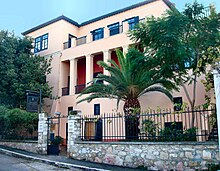Eduard Schaubert
Gustav Eduard Schaubert (born July 27, 1804 in Breslau ; † March 30, 1860 there ) was a Prussian architect who played a major role in the redesign of the Greek capital Athens after the Greek Revolution .
Life
Schaubert studied in Breslau and at the Berlin Building Academy , where he was a student of Karl Friedrich Schinkel .
Urban planning of Athens
With his college friend Stamatios Kleanthis he was one of the pioneers of urban development in Greece in the 19th century; After training in Berlin under Karl Friedrich Schinkel, the two architects began their professional careers in Athens under Ioannis Kapodistrias . In 1831 they made a topographical map of Athens showing the ancient ruins, Byzantine churches and buildings of the old city. This very detailed map served as the basis for building a modern capital city.
The basic orientation of the new city layout, which was laid out under the protection of the old town north of the ancient city, shows a regular expansion north of the acropolis and the old town in the form of a triangle with squares at its corners. The result was a classicist cityscape with radial main views and views of the Acropolis and the Kapnikarea Church. The floor plan takes into account ancient excavations such as the Acropolis and combines ideas of absolutism such as the orientation towards the royal palace to be built (as in Karlsruhe ) with those of philhellenism (inclusion of archaeological sites and reshaping of the medieval city). Although this plan was subjected to changes, namely by Leo von Klenze (1784–1864), the architect of King Ludwig of Bavaria, the design was carried out and later served as a model, especially for the cities of Piraeus and Eretria .
Urban planning of Piraeus and Eretria
After creating the plans for Piraeus with Kleanthes , Schaubert drafted the plans for Eretria on his own . He designed a planned city for 10,000 inhabitants. His plan was characterized by an opening to the bay, which served as a port, and the inclusion of the most important archaeological sites. As in Athens, he planned different viewpoints along the north-south axis between the town hall, market ( agora ), church and the Acropolis, but also between the naval school and library, which were arranged on the axis of the ancient theater.
Archaeological activities
In 1836, Schaubert and Hans Christian Hansen were involved in the restoration of the Niketemple on the Acropolis under the direction of the archaeologist Ludwig Ross . The Niketempel became known in Germany for research into the history of art when Ross, Schaubert and Hansen published a book together in Berlin in 1839 about the excavations and the rebuilding of the building.
In 1845/1846, Schaubert carried out the excavation of the so-called Koroibos grave on behalf of Ludwig Ross . Ancient sources tell Koroibos von Elis as the first winner in the Olympic stadium run. His fictional victory in 776 BC BC establishes the ancient counting of the Olympics and is the earliest ancient historical date in European history. The excavation work on the so-called Koroibos grave was financed by the Prussian King Friedrich Wilhelm IV. Schaubert's excavation is a forerunner of the German Olympic excavations.
Schaubert and Kleanthis set up their architectural office on Tholos Street in the Plaka district of Athens ; the building now houses the Museum of the University of Athens.
Fonts
- with Ludwig Ross and Christian Hansen : The Acropolis of Athens according to the latest excavations. Dept. I: The Temple of Nike Apteros. Berlin 1839 ( digitized from Heidelberg University Library ).
literature
- Alexander Papageorgiou-Venetas: Eduard Schaubert. The urban development estate for the planning of the cities of Athens and Piraeus (= Peleus , Volume 11.) Bibliopolis, Mannheim 2001, ISBN 3-933925-21-5 .
- Stefan Lehmann : Olympia, the grave of Koroibos and the ancient sciences in Halle. In: Institute for Sport History of the German Sport University Cologne, Carl and Liselott Diem Archive (ed.): Olympically moves. Festschrift for Manfred Lämmer's 60th birthday. Cologne 2003, ISBN 3-88338-006-7 , pp. 163-175.
Web links
Individual evidence
- ^ Wilhelm Maria Barth, Max Kehrig-Korn: Die Philhellenenzeit . Hueber, Munich 1960, p. 20, note 1.
| personal data | |
|---|---|
| SURNAME | Schaubert, Eduard |
| BRIEF DESCRIPTION | German architect |
| DATE OF BIRTH | July 27, 1804 |
| PLACE OF BIRTH | Wroclaw |
| DATE OF DEATH | March 30, 1860 |
| Place of death | Wroclaw |

